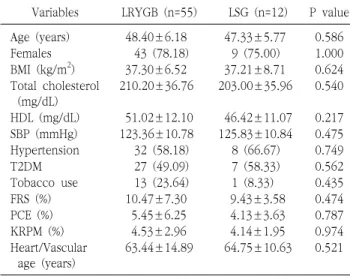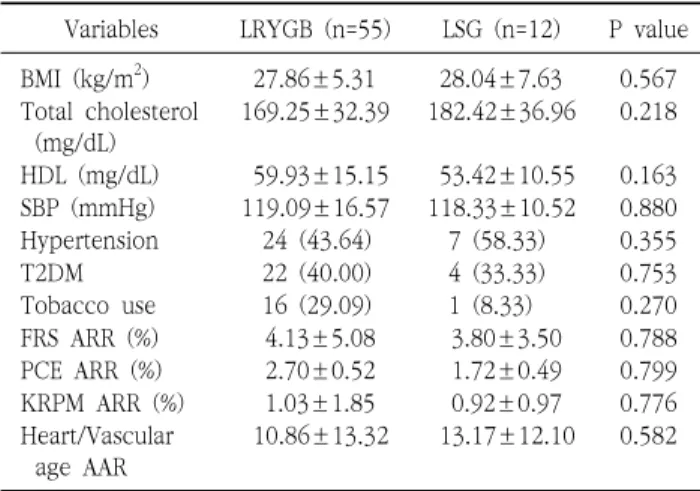ORIGINAL ARTICLE
JMBS Journal of Metabolic and Bariatric Surgery https://doi.org/10.17476/jmbs.2019.8.1.1
Received: May 27, 2019, Revised: June 17, 2019, Accepted: June 17, 2019
Corresponding author: Sang Hyun Kim, 59 Daesagwan-ro, Yongsan-gu, Seoul 04401, Korea
Department of Surgery, Soonchunhyang University Hospital Seoul, Soonchunhyang University School of Medicine Tel: +82-2-710-3234, Fax: +82-2-710-3088, E-mail: ssan77@naver.com/ssan77gs@gmail.com
CC This is an open access article distributed under the terms of the Creative Commons Attribution Non-Commercial License (http://creativecommons.org/licenses/by-nc/4.0)
which permits unrestricted non-commercial use, distribution, and reproduction in any medium, provided the original work is properly cited.
Impact of Bariatric Surgery on Cardiovascular Risk Reduction in Korean Obese Patients
Departments of
1Surgery and
2Urology, Soonchunhyang University Hospital Seoul, Soonchunhyang University School of Medicine,
3
Department of Surgery, Vievisnamuh Hospital, Seoul, Korea
Dong Jae Jeon
1, Sang Hyun Kim
1, Jae Heon Kim
2, Yong Jin Kim
3
Purpose: Morbid obesity is a well-known risk factor for cardiovascular disease (CVD). This study aimed to quantitatively evaluate the effects of bariatric surgery on CVD risk reduction in Korean obese patients by using three CVD risk prediction models (Framingham General Cardiovascular Risk Score [FRS], Pooled Cohort Equation [PCE], and Korean Risk Prediction Model [KRPM]), and to investigate which procedure between laparoscopic Roux-en Y gastric bypass (LRYGB) and laparoscopic sleeve gastrectomy (LSG) is a better option for CVD risk reduction. Materials and Methods: We retrospectively reviewed all obese patients who underwent bariatric surgery at a single institution from October 2009 to May 2016. Of the 1034 patients reviewed, 83 patients (6.5%) who met the criteria for calculating the FRS, PCE, and KRPM scores and had a follow-up of at least 1 year were included in this study. Results: The FRS, PCE, and KRPM scores were significantly decreased at postoperative 1 year (10.47±7.30% to 6.33±4.59%, P=0.000; 5.45±6.25% to 2.75±2.75%, P=0.000; and 4.53±2.96% to 3.49±2.13%, P=0.000, respectively) in LRYGB. The PCE and KRPM scores were significantly decreased (4.13±3.63% to 2.42±2.45%, P=0.004 and 4.14±1.95% to 3.22±1.94%, P=0.000, respectively) in LSG, but not the FRS (9.43±3.58% to 5.63±3.24%, P=0.118). There was no difference in absolute risk reduction in FRS, PCE, and KRPM between LRYGB and LSG (4.13±5.08% and 3.80±3.50%, P=0.788; 2.70±0.52% and 1.72±0.49%, P=0.799; and 1.03±1.85% and 0.92±0.97%, P=0.776, respectively). Conclusion: LRYGB and LSG can equally significantly decrease the CVD risk in the Korean population, based on FRS, PCE, and KRPM.
Key Words: Cardiovascular diseases, Risk assessment, Bariatric surgery, Roux-en-Y gastric bypass, Morbid obesity
INTRODUCTION
Morbid obesity and its associated comorbidities are important public health problems worldwide. Over the past several decades, the prevalence of obesity has been dramatically increasing in all populations. According to the updated data of the World Health Organization in 2017, the number of overweight and obese adults globally was >1.9
billion (39%) and >650 million (13%), respectively, in
2016, and the worldwide prevalence of obesity nearly
tripled between 1975 and 2016 [1]. In Korea, the
prevalence of obesity with a body mass index (BMI) of ≥30
kg/m
2 has rapidly increased, with the prevalence in 2013
(4.2%) being almost double that in 2002 (2.5%) [2]. As the
obese population increases in number, the incidence of
type 2 diabetes mellitus (T2DM), hypertension, dyslipidemia,


